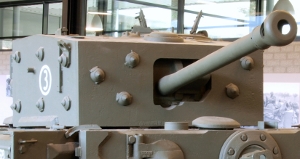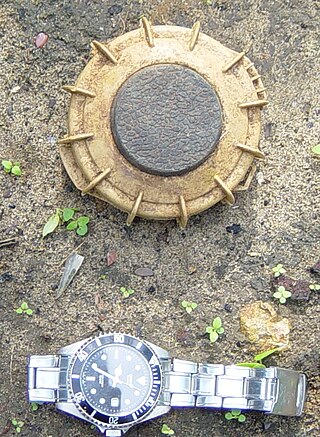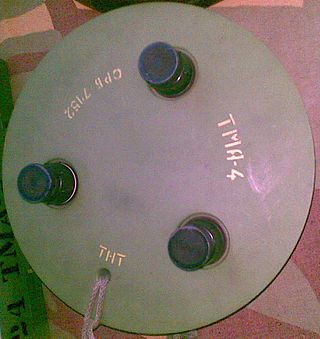Related Research Articles

In anti-tank warfare, an anti-tank mine is a type of land mine designed to damage or destroy vehicles including tanks and armored fighting vehicles.

The Ordnance QF 75 mm, abbreviated to OQF 75 mm, was a British tank gun of the Second World War. It was obtained by boring out the Ordnance QF 6-pounder 57 mm anti-tank gun to 75 mm, to give better performance against infantry targets similarly to the 75 mm M3 gun fitted to the American Sherman tank. The QF came from "quick-firing", referring to the use of ammunition where the shell has a fixed cartridge. The gun was also sometimes known as ROQF from Royal Ordnance Quick-Firing.

The Tellermine 42 (T.Mi.42) was a German metal-cased anti-tank blast mine used during the Second World War. The mine was a development of the Tellermine 35 with improved resistance to blast. It was followed by the simplified Tellermine 43. The Tellermine consists of a circular pressed steel main body with a large central pressure plate. The pressure plate is smaller than the earlier Tellermine 35, which increases the mine's resistance to blast. Two secondary fuze wells are provided for anti-handling devices, one in the side, and one on the bottom of the mine. The mine has a carrying handle.

The Tellermine 43 was a German circular steel-cased anti-tank blast mine used during the Second World War. It was a simplified version of the Tellermine 42, which enabled simpler production techniques. Between March 1943 and the end of World War II, Germany produced over 3.6 million Tellermine 43s. Several countries produced copies of the mine including Denmark (M/47), France and Yugoslavia (TMM-1).
The L9 bar mine is a large rectangular British anti-tank landmine. The bar mine's principal advantage is its long length, and therefore its trigger length. A typical anti-tank landmine is circular, and a vehicle's wheels or tracks, which make up only a small proportion of its total width, must actually press on the mine to activate it. To increase the probability of a vehicle striking the mine, the mine's effective trigger width must be increased.

The PMN series of blast anti-personnel mines were designed and manufactured in the Soviet Union. They are one of the most widely used and commonly found devices during demining operations. They are sometimes nicknamed "black widow" because of their dark casings.

The M15 mine is a large circular United States anti-tank blast mine, first deployed during the Korean War. Essentially, it is a larger version of the M6A2 anti-tank mine, which it replaced. Although the M15 has been superseded by the M19 mine, the U.S. retains large stocks of M15s because they are still regarded as reliable and effective weapons. When used against main battle tanks the M15 is primarily a "track-breaker" which creates mobility kills, but has a comparatively small likelihood of causing crew fatalities. However, when used against light vehicles such as APCs or unarmored vehicles such as trucks the damage it can inflict is much more severe.

The VS-1.6 is an Italian circular plastic-cased scatterable anti-tank blast mine. It has very few metal components and is resistant to overpressure and shock. The mine can also be deployed conventionally and from helicopters. It was produced by Valsella Meccanotecnica, but production has ceased.

The VS-50 is a circular plastic-cased anti-personnel blast mine that entered production in 1985. It was formerly made by the now-defunct Valsella Meccanotecnica SpA, an Italian high-tech defence company specialized in area denial systems. The company also the made the Valmara 69, and was one of the first to implement plastic construction for landmines. The VS-50's design is similar to that of the TS-50 and VS-MK2 mines. It is blast resistant and can be used in a minimum metal configuration. Though unlikely to kill, its explosive charge is quite sufficient to destroy the victim's foot, being capable of penetrating 5 mm of mild steel leaving an 80 mm-diameter hole.
The PM-60 or K-1 is a German round plastic cased minimum metal anti-tank blast mine. The case of the mine consists of two halves joined by sixteen plastic nuts, giving the mine a distinctive appearance. The top of the mine has a large pressure plate which rests on top of the fuze assembly. Two fuzes are available for the mine, a conventional ball bearing retained striker and a chemical fuze, containing a glass ampule of acid over a flash composition. When the mine is deployed with the chemical fuze it is very difficult to detect because the only metal in the mine is the detonator capsule. There is a secondary fuze well on the bottom of the mine that can accept a fuze allowing remote command detonation of the mine.
The PRB M3 and PRB M3A1 are plastic cased minimum metal anti-tank blast mine produced by the Belgian company Poudreries Réunies de Belgique in the 1970s and 1980s. The mine is square with an olive drab body constructed from polythene with a webbing carrying handle on the side and an ammonia-free bakelite seating for the pressure plate to be screwed into. The fuze well is in the centre of the seating, with the pressure plate screwed into it after the fuze has been inserted. The cylindrical pressure plate consists of two plastic plates, one of which moves under the weight of a vehicle driving over the mine to transmit the force to the fuze, shearing pins which hold it in place.
The M6, M6A1 and M6A2 are a series of metal-cased, circular, heavy anti-tank landmines produced by the United States from May 1944 to May 1945.

The TMA-4 is a circular plastic cased Yugoslavian minimum metal anti-tank blast mine. It is a modernized version of the TMA-3. The mine is basically a cast block of TNT with three fuze wells cut into it, encased in plastic. Three black plastic UTMA-4 fuzes are installed into the top surface of the mine. A thin rope carry handle is also provided. The small pressure plate area of the fuzes make the mine resistant to overpressure from explosive demining techniques. Additionally the low metal content of the mine make it very difficult to detect. Although no secondary fuze well is provided, it is possible that the mine could be fitted with improvised anti-handling devices.
The FMK-1 is a small circular Argentina anti-personnel blast mine which, when fitted with a stiffened pressure plate, is also used as the fuze for the FMK-3 and FMK-5 anti-tank mines. The mine has a circular plastic body, with a number of small ribs running vertically around the outside of the mine, with the circular detonator and striker protruding on each side. The pressure plate has a distinctive six pointed star shape ribbing for stiffness. The bottom of the mine has small base plug inside which a small stud is installed. The stud increases the activation pressure of the mine. A metal detector disc can be added to the bottom of the mine, but it is not often used. It is actually in service with the Argentine Army.
The PDM amphibious mines are series of Soviet anti-vehicle mines that could be used on or in beaches, rivers, lakes and shallow coastal waters up to five meters deep.

The Teller mine was a German-made antitank mine common in World War II. With explosives sealed inside a sheet metal casing and fitted with a pressure-actuated fuze, Teller mines had a built-in carrying handle on the side. As the name suggests the mines were plate-shaped.

An anti-handling device is an attachment to or an integral part of a landmine or other munition such as some fuze types found in general-purpose air-dropped bombs, cluster bombs and sea mines. It is designed to prevent tampering or disabling, or to target bomb disposal personnel. When the protected device is disturbed, it detonates, killing or injuring anyone within the blast area. There is a strong functional overlap of booby traps and anti-handling devices.

The Anti-Tank Mine General Service Mark II was a British anti-tank blast mine used during the Second World War.
The VAR/40, VAR/100 and VAR/100/SP are Italian anti-personnel blast landmines produced by the Tecnovar italiana S.p.A. company.
In military munitions, a fuze is the part of the device that initiates its function. In some applications, such as torpedoes, a fuze may be identified by function as the exploder. The relative complexity of even the earliest fuze designs can be seen in cutaway diagrams.
References
- Jane's Mines and Mine Clearance 2005-2006